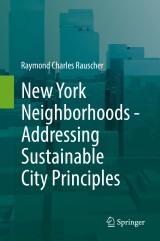Details

New York Neighborhoods - Addressing Sustainable City Principles
|
96,29 € |
|
| Verlag: | Springer |
| Format: | |
| Veröffentl.: | 01.09.2017 |
| ISBN/EAN: | 9783319604800 |
| Sprache: | englisch |
Dieses eBook enthält ein Wasserzeichen.
Beschreibungen
This book examines the neighborhoods of New York City to determine to what extent planning in New York addresses Sustainable City Principles (SCPs). Part I looks at the background to planning urban areas in the face of global urban changes. These changes (i.e. population movements and densification of cities) are placing pressures on cities worldwide. Chapter 1 provides a background to these global pressures (i.e. population growth) and their implications. Chapter 2 looks closer at New York planning and introduces Sustainable City Principles (SCPs). Part II introduces nine selected neighborhoods within Manhattan and examines to what extent planning of these neighborhoods addresses the SCPs. For each chapter a neighborhood background is provided and results of the author’s field survey are reviewed. Part III examines the selected neighborhoods within Brooklyn to determine to what extent planning of those neighborhoods addresses the SCPs. Part IV examines the last three neighborhoods (in Queens) and addresses the SCPs. Part V examines conclusions reached from examining the nine neighborhoods. These conclusions are used to determine the extent that the City Council (and the community) are addressing SCPs in planning neighborhoods. Finally, lessons learned from these conclusions are assessed for their relevance to planning neighborhoods anywhere in the world.
<p>Part 1: Global Urban Change.- Chapter 1. Global Changes and Implications for Cities.- Chapter 2. New York and Sustainable City Principles.- Part II : Manhattan Neighborhoods and sustainable City Principles.- Chapter 3. Lower East Side and Sustainable City Principles.- Chapter 4. Greenwich Village and Sustainable City Principles.- Chapter 5. Hell’s Kitchen and Sustainable City Principles.- Part III : Brooklyn Neighborhoods and Sustainable City.- Chapter 6. DUMBO and Sustainable City Principles.- Chapter 7. Brooklyn Downtown and Sustainable City Principles.- Chapter 8. Greenpoint and Sustainable City Principles.- Part IV: Queens Neighborhoods and Sustainable City<b> </b>Principles.- Chapter 9 . Astoria and Sustainable City Principles.- Chapter 10. Jackson Heights and Sustainable City Principles.- Chapter 11. Long Island City and Sustainable City Principles.- Part V : Conclusions and Future Directions.- Ch</p><p></p><p></p>apter 12. Directions for Planning Sustainable Cities and Neighborhoods.
<b>Raymond Charles Rauscher </b>is a conjoint lecturer at the University of Newcastle, Australia, and a director of the Habitat Association for Arts and Environment Inc. Ray was born in Brooklyn, New York City (1943), and graduated from the City College of New York (Bachelor of Engineering (Civil) (1966)). He later completed part one of a master’s degree at the University of Michigan (research on Detroit entitled <i>A </i><i>Solution to the Urban Crisis: Proposal for the Creation of Region Serving New Cities </i>(unpublished 1969)). His<i> </i>Master of Town and Country Planning degree was completed at the University of Sydney (1971), including a thesis <i>Community Response to a Redevelopment</i> <i>Proposal </i>(Sydney) (University of Sydney Library Microfilm Department 1971). The thesis covered planning conflicts in Erskineville (Sydney) and a framework to resolve urban planning conflicts. Delving into the subject of sustainable urban planning (SUP), Ray completed a PhD (2009) at the University of Newcastle, Australia. Following further research, Ray published <i>Sustainable Communities: A</i> <i>Framework for Planning </i>(Springer 2014). Moving to address urban renewal, Ray completed research and published <i>Brooklyn’s Bushwick – Urban Renewal in</i> <i>New York, USA </i>(Springer 2014). Researching further, Ray then examined urban planning (from the 1970s) in inner city neighborhoods of Sydney, publishing <i>Sustainable Neighborhoods in Australia: City of Sydney Urban Change </i>(Springer 2015). Moving from the inner city planning, Ray then researched how cities were coping with today’s impacts of global changes (i.e., population and environmental impacts) and published <i>Cities in Global Transition: Creating Sustainable</i> <i>Communities in Australia </i>(Springer 2016). The instance of these global impacts on neighborhoods led Ray to commence research on the extent that cities, in planning neighborhoods, address Sustainable City Principles. On further researching this question (and completing fieldwork over nine New York neighborhoods in 2014), Ray completed this book (<i>New York Neighborhoods – Addressing Sustainable City</i> <i>Principles</i>). Ray would appreciate hearing from any reader on his/her views on planning neighborhoods and cities (New York or anywhere) (ray.r@idl.net.au).<div><div> </div></div>
This book examines the neighborhoods of New York City to determine to what extent planning in New York addresses Sustainable City Principles (SCPs). Part I looks at the background to planning urban areas in the face of global urban changes. These changes (i.e. population movements and densification of cities) are placing pressures on cities worldwide. Chapter 1 provides a background to these global pressures (i.e. population growth) and their implications. Chapter 2 looks closer at New York planning and introduces Sustainable City Principles (SCPs). Part II introduces nine selected neighborhoods within Manhattan and examines to what extent planning of these neighborhoods addresses the SCPs. For each chapter a neighborhood background is provided and results of the author’s field survey are reviewed. Part III examines the selected neighborhoods within Brooklyn to determine to what extent planning of those neighborhoods addresses the SCPs. Part IV examines the last three neighborhoods (in Queens) and addresses the SCPs. Part V examines conclusions reached from examining the nine neighborhoods. These conclusions are used to determine the extent that the City Council (and the community) are addressing SCPs in planning neighborhoods. Finally, lessons learned from these conclusions are assessed for their relevance to planning neighborhoods anywhere in the world.<br>
<p>Offers the latest interpretation of sustainable urban planning</p><p>Provides a hands-on approach to achieving sustainable neighborhoods</p><p>An important text for academics and practitioners</p>
<p></p> <p>Offers the latest interpretation of sustainable urban planning</p> <p>Provides a hands-on approach to achieving sustainable neighborhoods</p><p>An important text for academics and practitioners<br></p><p><br></p>
Diese Produkte könnten Sie auch interessieren:

Sustainable Cities for the Third Millennium: The Odyssey of Urban Excellence

von: Voula P. Mega

96,29 €















